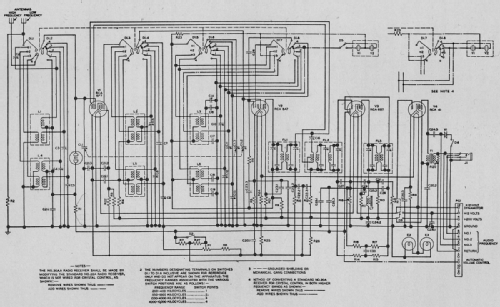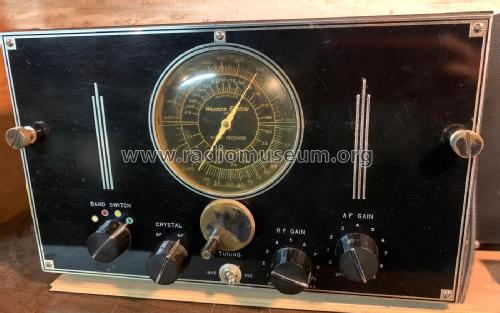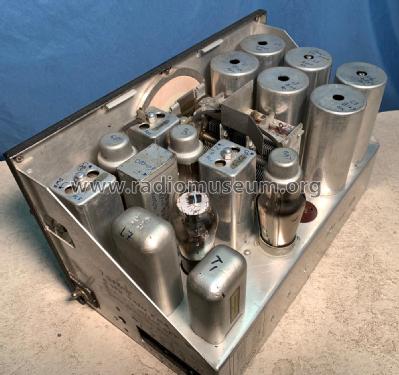20A aircraft receiver base station version
Western Electric Company Inc.; New York (NY)
- Pays
- Etats-Unis
- Fabricant / Marque
- Western Electric Company Inc.; New York (NY)
- Année
- 1936 ?
- Catégorie
- Récepteur amateur (bandes amateurs, ev. avec bande AM)
- Radiomuseum.org ID
- 314656
Cliquez sur la vignette du schéma pour le demander en tant que document gratuit.
- No. de tubes
- 4
- Principe général
- Super hétérodyne, circuits FI avec réaction; FI/IF 96 kHz; 2 Etage(s) BF
- Circuits accordés
- 2 Circuits MA (AM)
- Gammes d'ondes
- PO, GO et 2 x OC
- Tension / type courant
- Alimentation externe ou alimentation principale / 200 vdc & 12 vdc Volt
- Haut-parleur
- - Pour casque ou amplificateur BF
- Matière
- Boitier métallique
- De Radiomuseum.org
- Modèle: 20A aircraft receiver [base station version] - Western Electric Company Inc.;
- Forme
- Formes diverses décrites en notes
- Dimensions (LHP)
- 13 x 8 x 9 inch / 330 x 203 x 229 mm
- Remarques
-
Amelia Earhart used this model aircraft radio receiver on her ill-fated 1937 flight from New Guinea to Howland Island in the Pacific. It was available in the base station configuration you see here. With the face plate removed, a mechanism could be installed that made it possible to control the radio from the cockpit by mechanical remote control. Some say that the shortcomings of this radio contributed to the failure of the flight.
The manufacturer's intention was to create a radio that was compact and light weight. They did several things to accomplish this. They used a 6F7 dual function tube that served as both an RF and IF amplifier. They included regeneration to increase gain. They used a 6B7 tube that served four functions (IF amplifier, 2nd detector, AVC), then after demodulation the audio signal was passed through the tube again for amplification. The circuit was very compact and difficult to trace and troubleshoot. The compactness could lead to internal feedback problems.
The output was through headphones and required two antennas. (high and low frequencies). The output tube was a type 41. The power requirement was 200 VDC and 12 VDC provided by a generator run by one of the engines.
The case is a rectangular aluminum box (removed in photos).
- Poids net
- 15 lb (15 lb 0 oz) / 6.810 kg
- Schémathèque (2)
- - - Manufacturers Literature
- Auteur
- Modèle crée par Ron Boucher. Voir les propositions de modification pour les contributeurs supplémentaires.
- D'autres Modèles
-
Vous pourrez trouver sous ce lien 171 modèles d'appareils, 150 avec des images et 32 avec des schémas.
Tous les appareils de Western Electric Company Inc.; New York (NY)
Collections
Le modèle 20A aircraft receiver fait partie des collections des membres suivants.


